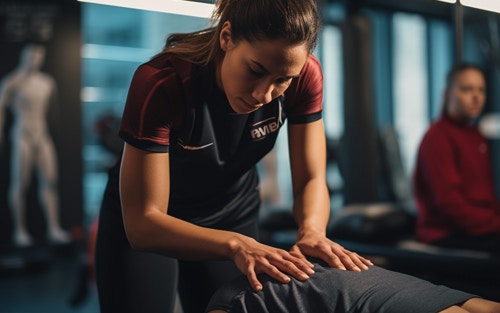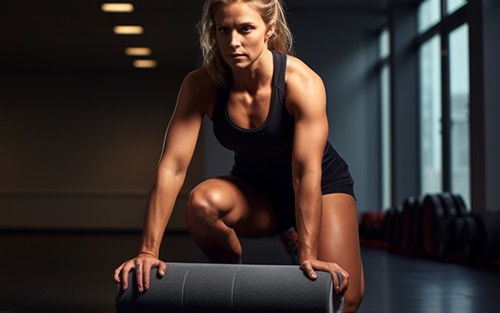Are you an athlete or someone with a physically demanding lifestyle? Then you may have heard of sports massage. But did you know this type of massage can offer many benefits beyond what you might expect? In this comprehensive guide, we will delve into the world of sports massage, its history, techniques, types, and how it compares to other forms of massage. We will also explore the benefits, side effects, and precautions associated with this therapy and provide valuable tips for finding a qualified therapist and trying some DIY techniques. So, what is a sports massage? Let’s find out.
Short Summary
- Sports massage is a specialized form of bodywork used to prevent and treat injuries, prepare the body for physical activity, and aid athletes in recovery.
- It consists of pre-event, post-event, and maintenance types with various benefits such as improved flexibility & reduced fatigue.
- People of all activity levels can benefit, but precautions must be taken when finding a qualified therapist or using DIY techniques at home.
Understanding Sports Massage

Sports massage is a specialized form of bodywork designed to prevent injuries, prepare the body for athletic activity, and help athletes recover from workouts and injuries. It can benefit professional athletes and individuals with labor-intensive occupations or pastimes.
The techniques utilized in sports massage include effleurage, kneading, and trigger pointing, which aim to relieve muscle tension and promote relaxation.
History of Sports Massage
The roots of sports massage can be traced back to ancient Greek and Roman times when massage and exercise were combined in athletic training. In various Asian cultures, soft tissue massage techniques were employed for dancers and martial arts practitioners.
It wasn’t until the 1960s that sports massage became a formal practice, predominantly in the Soviet Union and Communist bloc countries, where it was used to help athletes with tight muscles and other performance-related issues.
Key Techniques
Effleurage, a technique used to spread oil and warm up the soft tissues, helps create a calming, relaxing effect both physiologically and psychologically. Kneading, which involves lifting, squeezing, and manipulating tissues during a sports massage session, is utilized to mobilize tissue, enhance blood flow, and aid in stimulating the removal of waste products.

Another technique, trigger pointing, is employed to:
- Release contracted muscle knots, thereby relieving muscle tension
- Decrease discomfort
- Augment range of motion
- Enhance muscle function
Sports massage has been proven effective in reducing delayed onset muscle soreness (DOMS). This helps athletes recover quickly from strenuous activities and perform better.
Types of Sports Massage
Sports massage therapy encompasses three primary types: pre-event, post-event, and maintenance. Each type offers different benefits, such as increased flexibility, reduced fatigue, and improved endurance.
Let’s delve into each type and explore their specific purposes and benefits.
Pre-Event Sports Massage
Pre-event sports massage is a focused massage performed before an athletic event to prevent injury, stimulate muscles, and mentally prepare athletes for competition. Exercises like brisk walking are used to warm up the muscles. This helps the movement of muscles be smooth and reduces muscle tension.

Pre-event sports massage offers numerous advantages, including:
- Increased flexibility
- Reduced fatigue
- Improved endurance
- Enhanced performance
Techniques such as effleurage, petrissage, friction, and tapotement are typically incorporated in pre-event sports massage.
It is crucial to discuss any medical conditions, injuries, or medications with your massage therapist and stay hydrated before and after the massage.
Post-Event Sports Massage
A post-event sports massage is administered after an athletic event, typically within 1-2 hours of competing. Its primary objectives are:
- Reduce swelling resulting from microtraumas
- Loosen tight muscles
- Maintain flexibility
- Improve circulation to the muscle for better lactic acid elimination
- Prevent cramping
Sports massage has been proven effective in relieving DOMS due to metabolic changes in the muscles that cause pain both during and after exercise.
Maintenance Sports Massage
Maintenance sports massage focuses on the following:
- Improving athletic performance
- Increasing flexibility
- Reducing the risk of injury through regular sessions
- Facilitating the circulation of blood and nutrients to the muscles
- Maintaining the suppleness of the tissues
- Inhibiting the formation of scar tissue
- Enhancing flexibility and range of motion.
The advantages of maintenance sports massage, also known as sports massage benefits, include:
- Increased flexibility
- Improved circulation
- Augmented immune system
- Prevention of injury
- Release of endorphins
- Augmented range of movement
- Relaxation
Sports Massage vs. Deep Tissue Massage

While both sports massage and deep tissue massage share common goals of alleviating muscle pain and tension, they focus on different areas and offer distinct therapeutic benefits. Sports massage concentrates on the most vulnerable areas to injury or strain and those areas that have accumulated a greater degree of tension. Deep tissue massage works on the deepest layers of muscle tissue to help with full-body relaxation. Also, deep tissue massage therapy targets muscles that traditional massage can’t reach.
Therapeutically, sports massage aims to alleviate injuries sustained by athletes, such as hamstring strains or shin splints. In contrast, deep tissue massage reduces minor, more recent areas of muscular tension in the tissue and breaks apart adhesions in the fascia. Despite these differences, both types of massage employ similar strokes, such as kneading, circular movements, and tapping, to alleviate muscular pain and tension.
Who Can Benefit from Sports Massage?
While the name “sports massage” might suggest that it is exclusive to athletes, this form of massage therapy can benefit many individuals, not just professional athletes. Those with labor-intensive occupations or physically demanding hobbies can also experience the many benefits of sports massage, such as increased flexibility, improved circulation, and reduced muscle tension.
Side Effects and Precautions

Before getting a sports massage, it is essential to consider potential side effects and take necessary precautions. It is important to see a doctor before getting a sports massage if you have any of the following:
- Acute infectious diseases
- Aneurysms
- Heavy bruising
- Cancer
- Hernias
- High blood pressure
- Inflammation due to tissue damage
- Osteoporosis
- Phlebitis
- Varicose veins
- Certain skin conditions
Receiving a massage in any of these conditions can be dangerous.
Sports massage requires a person to be fit and sober. Individuals who are intoxicated cannot take advantage of this therapy.
Finding a Qualified Sports Massage Therapist

To ensure you receive the best possible treatment, finding a certified sports massage therapist with the appropriate training and credentials is essential. The National Certification Board for Therapeutic Massage & Bodywork (NCBTMB) provides a Find A Nationally Certified Practitioner database, and the American Massage Therapy Association (AMTA) offers a Find a Massage Therapist database.
A credentialed sports massage therapist is specially qualified to assist individuals with diverse sports injuries and aid in avoiding potential injuries related to the sport or activity in question.
DIY Sports Massage Techniques
If you prefer to try sports massage techniques at home, there are several options available, such as:
- Tapping
- Using foam rollers
- Using athletic balls
- Applying firm pressure on trigger points
- Massage guns, handheld devices that apply percussive therapy to alleviate muscle tension and soreness, have also gained popularity for at-home use.

When employing DIY sports massage techniques, it is imperative to be cognizant of your limitations and exercise caution when applying pressure. Be aware of any underlying medical conditions that may be impacted by the massage.
Summary
In conclusion, sports massage offers numerous benefits for athletes and non-athletes, from injury prevention to improved performance and recovery. Understanding the history, techniques, and types of sports massage and the differences between sports and deep tissue massage can help individuals make informed decisions about their massage therapy needs. With the proper precautions, finding a qualified sports massage therapist, or even trying DIY techniques, sports massage can be a valuable addition to anyone’s wellness routine.
Frequently Asked Questions
What do they do in a sports massage?
Sports massage therapy is a targeted deep-tissue massage that can be applied to specific body areas to help improve blood circulation, loosen muscle knots, and reduce lactic acid buildup.
It can help athletes recover from strenuous workouts, reduce pain and inflammation, and improve overall performance. It can also be used to help people with chronic pain and tension and those recovering from an injury.
What is the difference between a sports massage and a normal massage?
Sports massage is specifically tailored to target certain muscle groups and apply pressure on specific body parts, which can help improve performance.
While a normal massage typically works to relax muscles.
How do I know if I need a sports massage?
If you find yourself constantly feeling stiff after physical activity, experiencing achiness and tension, or feeling stress and anxiety, you could likely benefit from a sports massage.
These can be key signs that you need to see a massage therapist.
What are the key techniques used in sports massage?
Sports massage uses effleurage, kneading, and trigger-pointing techniques to relieve muscle tension and promote relief and relaxation.
Can non-athletes benefit from sports massage?
Non-athletes can benefit from sports massage. It is not only helpful to professional athletes but to anyone with a physically demanding occupation or hobby.
(706) 521-5290